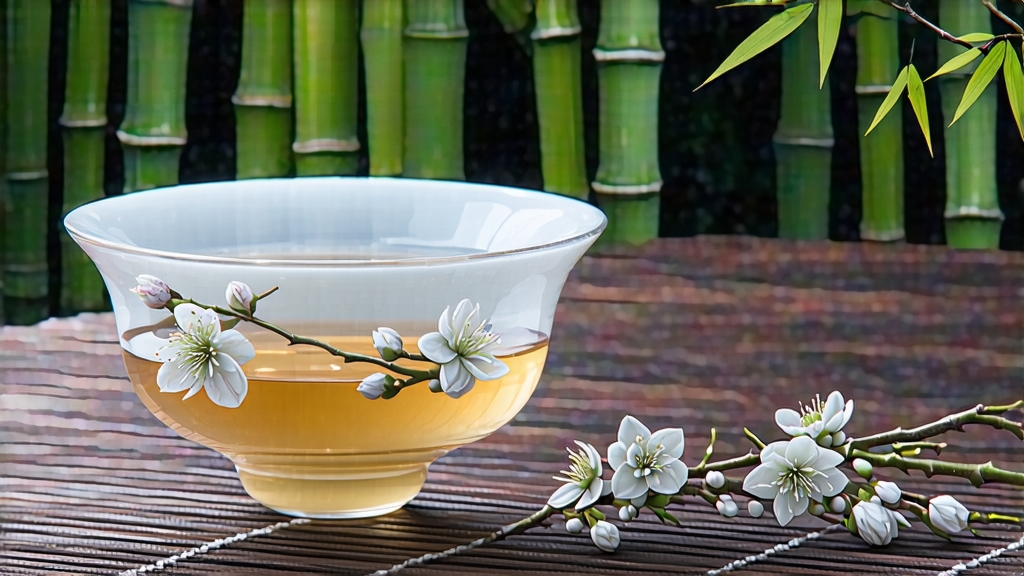
White tea is the quietest chapter in the long book of Chinese tea, and within that chapter Silver Needle—Bai Hao Yin Zhen—gleams like a single line of Tang-dynasty calligraphy written in moonlight. First praised in the Song imperial treatise “Da Guan Cha Lun” (1107 CE), the cultivar was originally reserved for the emperor’s cup; only in the late nineteenth century did it glide down the Min River to foreign ports, winning gold medals at the 1915 Panama-Pacific Expo and earning the English nickname “White Hair Silver Needle.” Today the name still describes the appearance of the tea: only the unopened bud, sheathed in silvery down, is plucked, making every leaf a tiny lance of spring.
Geography is the first secret. Authentic Silver Needle comes from two tiny counties in Fujian—Fuding and Zhenghe—where subtropical humidity meets mineral-rich red-yellow soils. Day-night temperature swings of 10 °C slow the growth of the Da Bai (Big White) and Da Hao (Big Down) cultivars, concentrating amino acids and the fuzzy trichomes that give the tea its sweet, marine aroma. Above the tea gardens, morning mists act like natural shade cloth, softening sunlight so that chlorophyll retreats and the bud stays pale. Walk through those gardens in late March and you will hear only two sounds: the click of pruning shears and the soft fall of buds into wicker baskets lined with banana leaf.
Plucking rules are stricter than any appellation in wine: only on clear days between 9 a.m. and 2 p.m., when surface moisture has evaporated; only buds 1.5–2.5 cm long; only two kilograms per picker per day. By dusk the harvest is already on bamboo trays in the withering loft, beginning the two-day transformation that defines white tea. No wok firing, no rolling, no shaking—just the patient dialogue between air and leaf. For the first twelve hours the buds rest in a draft of 22–26 °C, losing roughly 20 % moisture and developing a faint cucumber note. Then the tea master shifts the trays to a warmer loft (28–30 °C) where the oxidation enzymes wake, turning catechins into delicate theaflavins. The process is neither fully enzymatic like oolong nor fully arrested like green tea; it drifts, like a boat untied. When the bud feels leather-tough and the down stands erect, the tea is moved to a charcoal-warmed chamber for a final “foot-drying” at 40 °C, low enough to keep the bud intact yet hot enough to lock in the fragrance. Total water content must fall below 8 % so that the precious hairs will not mildew during the months of quiet aging that Silver Needle secretly loves.
Ageability is the second secret. Unlike most white teas, which fade after two years, a well-made Silver Needle begins to deepen after the third spring, developing honeyed notes reminiscent of aged Riesling. Fuding farmers store it in paper-lined tin cylinders buried in cool lofts; every year they open one can, sniff, and re-seal. The tea breathes, but only through the paper’s pores, slowly oxidizing until the liquor turns from pale chartreuse to deep amber and the aroma acquires the scent of dried longan and wet sandstone.
To brew the tea abroad, abandon teabags and electric kettles that boil water into violence. Use a tall glass gaiwan or a clear borosilicate pot so you can watch the buds stand upright like miniature lighthouse towers. Begin with 3 grams—about fifteen buds—for every 150 ml of water. Silver Needle is shy; water hotter than 85 °C will scorch the down and release harsh tannins. Rinse the buds for five seconds, not to clean but to wake them, then infuse 30 seconds. The first pour smells like fresh rain on hot limestone; the second, 45 seconds, tastes of honeydew and whipped cream; the third, one minute, brings a faint marine breeze. You can steep the same buds six times, lengthening each infusion by fifteen seconds, until the flavor bows out as gracefully as it entered. If you own a celadon cup with a pale glaze, use it; the color contrast will make the liquor glow like liquid topaz.
Tasting is meditation. Hold the cup at eye